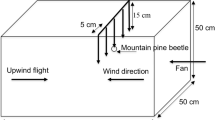Summary
The carabid beetle Nebria brevicollis (F.), despite being macropterous, has a very low flight potential. Only a few percent of the beetles has functional flight muscles, flight motivation is low, and the period favourable for flight is short. The inability to fly is caused mainly by arrested development of the flight muscles. Dispersers are formed only under favourable conditions in the larval stages as shown by laboratory experiments (much food, short daylength). In N. brevicollis dispersal by flight cannot be considered as a reaction to deteriorating conditions but just the other way round. Because of the usually low numbers of potential dispersers conditions during larval development are apparently suboptimal. However, N. brevicollis is widespread and abundant in our area. The “choice” of using energy for the metabolic costs of larval growth, and only secondarily for the building up of flight muscles does not prevent the species from fully exploiting the habitat.
Similar content being viewed by others
References
Aukema B (1986) Winglength determination in relation to dispersal by flight in two wing dimorphic species of Calathus Bonelli (Coleoptera, Carabidae). In: den Boer PJ, Luff ML, Mossakowski D, Weber F (eds) Carabid beetles, their adaptations and dynamics. Gustav Fischer, Stuttgart:91–99
Brandmayr P (1983) The main axis of the coenoclinal continuum from macroptery to brachyptery in carabid communities of the temperate zone. In: Brandmayr P, Den Boer PJ, Weber F (eds) The synthesis of field study and laboratory experiment. Report 4th Symp Carab '81. PUDOC Wageningen:147–169
De Kort CAD (1981) Hormonal and metabolic regulation of adult diapause in the Colorado beetle, Leptinotarsa decemlineata (Coleoptera, Chrysomelidae). Ent Gen 7:261–271
Den Boer PJ (ed) (1971) Dispersal and dispersal power of Carabid beetles. Miscell Papers LH Wageningen 8
Den Boer PJ (1977) Dispersal power and survival. Carabids in a cultivated countryside. Miscell Papers LH Wageningen 14:1–190
Den Boer PJ (1979) The individual behaviour and population dynamics of some carabid beetles of forests. In: Den Boer PJ, Thiele HU, Weber F (eds) On the evolution of behaviour in Carabid beetles. Miscell Papers LH Wageningen 18: 151–166
Den Boer PJ (1985) Fluctuations of density and survival of carabid populations. Oecologia (Berlin) 67:322–330
Den Boer PJ, Van Huizen THP, Den Boer-Daanje W, Aukema B, Den Bieman CFM (1980) Wing polymorphism and dimorphism in ground beetles as stages in an evolutionary process. Ent Gen 6:107–134
Dingle H (1972) Migration strategies of insects. Science 175:1327–1335
Fujisaki K (1986) Reproductive properties of the oriental chinch bug, Cavelerius saccharivorus Okajma (Heteroptera, Lygaeidae), in relation to its wing polymorphism. Res Popul Ecol 28:43–52
Haeck J (1971) The immigration and settlement of carabids in the new IJsselmeer-polders. In: Den Boer PJ (ed) Dispersal and dispersal power of carabid beetles. Miscell Papers LH Wageningen 8: 33–52
Harrison RG (1980) Dispersal polymorphisms in insects. Ann Rev Ecol Syst 11:95–118
Jackson DJ (1933) Observations on the flight muscles of Sitona weevils. Annals of appl Biology XX(4):731–770
Johnson CG (1969) Migration and dispersal of insects by flight. Methuen London
Johnson CG (1976) Lability of the flight system: a context for functional adaptation. Symp R Entomol Soc London 7:217–234
Kavanaugh DH (1979) Rates of taxonomically significant differentiation in relation to geographical isolation and habitat: Examples from a study of the neartic Nebria fauna. In: Erwin TL, Ball GE, Whitehead DR, Halpem AL (eds) Carabid beetles, their evolution, natural history and classification-Proc int Symp Carab, Washington, DC. Junk BV The Hague:35–57
Lindroth CH (1945) Die Fennoskandischen Carabidae I. Goteborgs kgl Vetensk Handl B 4(1):1–705
Nelemans MNE (1983) Flight-muscle development of the carabid beetle Nebria brevicollis (F). In: Brandmayr P, Den Boer PJ, Weber F (eds) The synthesis of field study and laboratory experiment. Report 4th Symp Carab '81 Pudoc Wageningen:45–51
Nelemans MNE (1986) Marking techniques for surface-dwelling Coleoptera larvae. Pedobiol 29:143–146
Nelemenas MNE (1987) On the life-history of the Carabid beetle Nebria brevicollis (F). Breeding experiments. Neth J Zool (in press)
Penney MM (1966) Studies on certain aspects of the ecology of Nebria brevicollis (F) (Coleoptera, Carabidae). J Anim Ecol 35:505–512
Scudder GGE (1975) Field studies on the flight muscle polymorphism in Cenocorixa (Hemiptera; Corixidae). Verh Intern Verein limnol 19:3064–3072
Smith DS (1964) The structure and development of flightless Coleoptera: A light and electron microscopic study of the wings, thoracic exoskeleton and rudimentary flight musculature. J Morph 114:107–184
Solbreck C (1986) Wing and flight muscle polymorphism in a lygaeid bug, Horvathrolus gibbicollis: determinants and life history consequences. Ecol Entom 11:435–444
Thiele HU (1977) Carabid beetles in their environments. Springer Berlin, Heidelberg, New York
Tietze F (1963) Untersuchungen ueber die Beziehungen zwischen Fluegelreduktion und Ausbildung des Metathorax bei Carabiden unter besonderer Beruecksichtigung der Flugmuskulatur (Coleoptera, Carabidae). Beitr Ent 13:87–163
Turin H, Haeck J, Hengeveld R (1977) Atlas of the Carabid beetles of the Netherlands. North-Holland Publ Comp Amsterdam.
Van der Eijk RH (1983) Population dynamics of gyrinid beetles. I. Flight activity of Gyrinus marinus Gyll (Col, Gyrinidae). Oecologia (Berlin) 57:55–64
Van Huizen THP (1977) The significance of flight activity in the life cycle of Amara plebeja Gyll (Coleoptera, Carabidae). Oecologia (Berlin) 29:27–41
Van Huizen THP (1979) Individual and environmental factors determining flight in Carabid beetles. In: Den Boer PJ, Thiele HU, Weber F (eds) On the evolution of behaviour in Carabid beetles. Miscell Papers LH Wageningen 18: 199–211
Van Schaick Zillesen PG, Brunsting AMH (1984) The influence of food quantity and photoperiod during the pre-adult stages on flight muscle development in adult Philonthus decorus (Coleoptera, Staphylinidae) and Pterostichus oblongopunctatus (Col, Carabidae). Ent Gen 9:143–147
Author information
Authors and Affiliations
Additional information
Communication No. 320 of the Biological Station, Wijster, The Netherlands
Rights and permissions
About this article
Cite this article
Nelemans, M.N.E. Possibilities for flight in the carabid beetle Nebria brevicollis (F.). Oecologia 72, 502–509 (1987). https://doi.org/10.1007/BF00378974
Received:
Issue Date:
DOI: https://doi.org/10.1007/BF00378974




